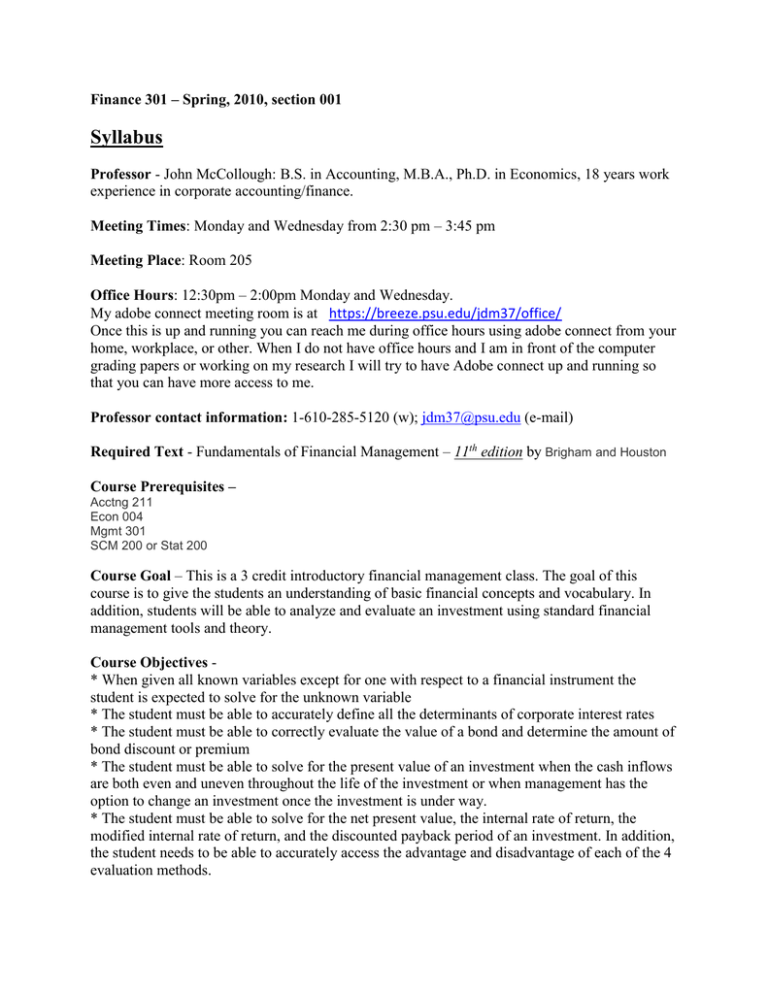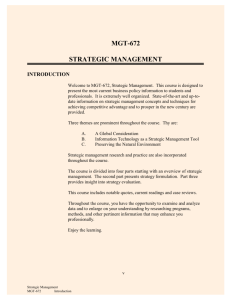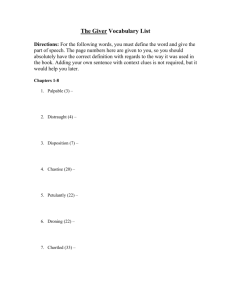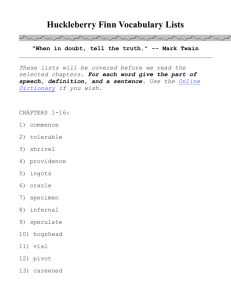Document
advertisement

Finance 301 – Spring, 2010, section 001 Syllabus Professor - John McCollough: B.S. in Accounting, M.B.A., Ph.D. in Economics, 18 years work experience in corporate accounting/finance. Meeting Times: Monday and Wednesday from 2:30 pm – 3:45 pm Meeting Place: Room 205 Office Hours: 12:30pm – 2:00pm Monday and Wednesday. My adobe connect meeting room is at https://breeze.psu.edu/jdm37/office/ Once this is up and running you can reach me during office hours using adobe connect from your home, workplace, or other. When I do not have office hours and I am in front of the computer grading papers or working on my research I will try to have Adobe connect up and running so that you can have more access to me. Professor contact information: 1-610-285-5120 (w); jdm37@psu.edu (e-mail) Required Text - Fundamentals of Financial Management – 11th edition by Brigham and Houston Course Prerequisites – Acctng 211 Econ 004 Mgmt 301 SCM 200 or Stat 200 Course Goal – This is a 3 credit introductory financial management class. The goal of this course is to give the students an understanding of basic financial concepts and vocabulary. In addition, students will be able to analyze and evaluate an investment using standard financial management tools and theory. Course Objectives * When given all known variables except for one with respect to a financial instrument the student is expected to solve for the unknown variable * The student must be able to accurately define all the determinants of corporate interest rates * The student must be able to correctly evaluate the value of a bond and determine the amount of bond discount or premium * The student must be able to solve for the present value of an investment when the cash inflows are both even and uneven throughout the life of the investment or when management has the option to change an investment once the investment is under way. * The student must be able to solve for the net present value, the internal rate of return, the modified internal rate of return, and the discounted payback period of an investment. In addition, the student needs to be able to accurately access the advantage and disadvantage of each of the 4 evaluation methods. * If an investment has several possible outcomes, the student must be able to solve for that investment’s level of risk per dollar of return * The student must be able to solve for the estimated price of a share of stock by using the required rate of return found by the CAPM method with the constant dividend growth model. * The student must be able to determine the correct value of a firm when that firm is not traded publicly by using the discounted expected free cash flow method. * From a given set of financial statements the student must be able to calculate a series of financial ratios, the firm’s weighted average cost of capital, the stock’s required rate of return, cash conversion cycle, and the company’s free cash flow. * The student will give a group presentation on a company that its group selects. The student’s group will state whether or not they feel that the company is a good buy and the student’s group will present detailed financial statistics which they have calculated (see above) to suppot their argument. Class Format – Class will begin promptly at 2:30 pm. Lecture will continue until 3:45 pm. The last half hour of either a Monday or a Wednesday class will be spent working on problem sets in collaboration with group members.These exercises will be similar in format to the exam questions.. In addition, on a random basis the first 5 minutes of class will consist of an extra credit question which will also be similar in format to an exam question. Class periods set aside for exam reviews will be of a question and answer format. Attendance policy – Although attendance is not mandatory for this class, prompt, on-time, attendance will directly impact your grade positively. The reason for this is that there will be inclass practice exercises that will be mandatory and count towards your overall grade. In addition, the exam questions will be look similar in format to the in-class practice exercises. There will also be an extra credit question given out from time to time in the beginning of class. Students who miss class or are late to class will not have the opportunity to make up the extra credit question. Grade Determination – There will be 4 exams. Your highest 3 exam grades will each count as 24% of your grade. Your lowest exam score will count only 12% of your grade. In addition, inclass practice exercises will count as another 11% of your grade. The grade for the in-class practice assignments will be determined by adding up all correct points awarded for each assignment and dividing that by the total number of points possible. Of the 11%, 3% will consist of your group member’s evaluation of you as a team member and a contributor to the homework problems. Finally, 5% of your grade is based on the in-class presentation due at the end of the semester. Your grade will be the average of your exam scores and the in-class practice exercises. To receive an “A” your average must be 93% or higher. To receive an “A-“ your average must be 90% - 92%. To receive a “B+” your average must be 87% - 89%. To receive a “B” your average must be 83% - 86%. To receive a “B-“ your average must be 80%-82% To receive a “C+” your average must be 77% - 79% To receive a “C” your average must be 70% - 76% To receive a “D” your average must be 60%-69% Anything less than 60% will be considered an F Exam Policy – The student must contact me within 24 hours of missing an exam and have a valid and verifiable excuse. An alternative make-up exam will be scheduled at the instructor’s convenience. If the student cannot make up the exam by the next class period then 30 points will be subtracted from his/her exam grade. I reserve the right to inspect any student’s calculator at any time during the exam. Extra credit points will be added to your lowest exam score. Therefore, there is a possibility that your lowest exam score might not end up being the lowest exam score and as a result it will be weighted 24% and your next lowest exam score will be weighted 12%. Student’s Expectations and Responsibilities- Please arrive to class on time and plan to remain for the entire class period. In consideration of the professor and the other students, and in order to maintain a college level learning environment, please refrain from side conversations while the lecture is taking place. Please remain seated during the lecture and do not leave the classroom during the lecture as this disrupts the focus and concentration of the professor and other students. In addition, please have cell phone turned off. The last 30 minutes of either Monday or Wednesday’s class will be spent in collaboration with fellow students on in-class exercises. Please understand that this does not mean class is over. You are required to stay during this time and to complete the in-class work. In-class work that is not completed must be completed outside of the classroom. In-class work is assigned in lieu of homework. Tentative Class Schedule: Week 1: 01/11 & 01/13 Lecture – chapters 1 & 2 Week 2: 01/20 (01/18 is MLK day) Lecture – chapters 2 Week 3: 01/25 & 01/27 Lectures – chapters 3 & 4 Week 4: 02/01 & 02/03 Lectures – 4 & 6 Week 5: 02/08 & 02/10 Test review on 02/08 – chapters 1-4, and chapter 6 Midterm # 1 on 02/10 covers chapters 1-4 and chapter 6 Week 6: 02/15 & 02/17 Lecture - chapter 5 & 7 Week 7: 02/22 & 02/24 Lecture – chapters 7 & 8 Week 8 : 03/01 & 03/03 Lecture – chapters 8 & 9 Spring Break Week of 03/08 -03/12 * No classes Week 9: 03/15 & 03/17 Lecture – chapter 9 Test Review on 03/17 – chapters 5,7,8,9 Week 10: 03/22 & 03/24 Midterm # 2 – covers chapters 5,7,8,9 Lecture – chapters 10 Week 11: 03/29 & 03/31 Lecture – chapters 11 & 12 Week 12: 04/05 & 04/07 Lecture – chapters 16 Week 13: 04/12 & 04/14 Test Review on 04/12 - chapters 10,11,12,16 Midterm #3– covers chapter 10, 11, 12, 16 Week 14: 04/19 & 04/21 Lecture – chapters 17 & 13 Week 15: 04/26 & 04/28 Lecture – chapters 18, 19, 20 Finals week – Final exam given – Chapter 13,17, 18,19,20 Academic Integrity Senate Policy 49-20 ACADEMIC INTEGRITY: Academic integrity is the pursuit of scholarly activity in an open, honest and responsible manner. Academic integrity is a basic guiding principle for all academic activity at The Pennsylvania State University, and all members of the University community are expected to act in accordance with this principle. Consistent with this expectation, the University's Code of Conduct states that all students should act with personal integrity, respect other students' dignity, rights and property, and help create and maintain an environment in which all can succeed through their efforts. Academic integrity includes a commitment not to engage in or tolerate acts of falsification, misrepresentation or deception. Such acts of dishonesty violate the fundamental ethical principles of the University community and compromise the worth of work completed by others. Academic dishonesty includes, but is not limited to cheating, plagiarism, fabrication of information or citation, prior possession of examinations, submitting work of another person or work previously used without informing the instructor, or tampering with the academic work of other students It is the policy in this course that while group discussion and collaboration for solving homework problems and to discuss concepts is strongly encouraged, group efforts (outside of laboratory) for any other reason, unless otherwise specified is not acceptable. Failure to conform to the previously stated policies, especially during exams, will result in a '0' for the particular activity and may result in an 'F' for the course. For procedural guidance, please contact the Student Government Association for assistance from an Academic Integrity Liaison. Students who are charged with an Academic Integrity violation may not withdraw from a course while a case is unresolved.





